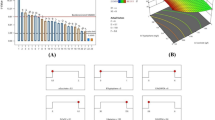Abstract
Cephamycin C is an extracellular broad spectrum β-lactam antibiotic produced by Streptomyces clavuligerus, S. cattleya and Nocardia lactamdurans. In the present study, different substrates for solid-state fermentation were screened for maximum cephamycin C production by S. clavuligerus NT4. The fermentation parameters such as substrate concentration, moisture content, potassium dihydrogen phosphate, inoculum size and ammonium oxalate were optimized by response surface methodology (RSM). The optimized conditions yielded 21.68 ± 0.76 mg gds−1 of cephamycin C as compared to 10.50 ± 1.04 mg gds−1 before optimization. Effect of various amino acids on cephamycin C production was further studied by using RSM, which resulted in increased yield of 27.41 ± 0.65 mg gds−1.





Similar content being viewed by others
References
Stapley EO, Jackson M, Hernandez S, Zimmerman SB, Currie SA, Mochale S, Mata JM, Woodruff HB, Henlin D (1972) Cephamycins, a new family of β-lactam antibiotics. Antimicrob Agents Chemother 2:122–131
Nagarajan R, Boeck LD, Gorman M, Hamill RL, Higgens CE, Hoehn MM, Starck WM, Whitney JG (1971) β-Lactam antibiotics from Streptomyces. J Am Chem Soc 93:2308–2310
Dutta JR, Dutta PK, Banerjee R (2004) Optimization of culture parameters for extracellular protease production from a newly isolated Pseudomonas sp. using response surface and artificial neural network models. Process Biochem 39:2193–2198
Xiong YH, Liu JZ, Song HY, Ji LN (2004) Enhanced production of extracellular ribonuclease from Aspergillus niger by optimization of culture conditions using response surface methodology. Biochem Eng J 21:27–32
Kalil SJ, Maugeri F, Rodrigues MI (2000) Response surface analysis and simulation as a tool for bioprocess design and optimization. Process Biochem 35:539–550
Rao JK, Kim C, Rhee S (2000) Statistical optimization of medium for the production of recombinant hirudin from Saccharomyces cerevisiae using response surface methodology. Process Biochem 35:639–647
Tsapatsaris S, Kotzekidou P (2004) Application of central composite design and response surface methodology to the fermentation of olive juice by Lactobacillus plantarum and Debaryomyces hansenii. Int J Food Microbiol 95:157–168
Omstead DR, Hunt GR, Buckland BC (1985) Comprehensive biotechnology: the principles, applications and regulations of biotechnology in industry, agriculture and medicine, vol 3. In: Moo-Young M (ed) Commercial production of cephamycin antibiotics. Pergamon, Oxford, pp 187–210
Inamine E, Birnbaum J (1973) Fermentation process. US Patent 3 770 590
Inamine E, Birnbaum J (1975a) Fermentation Process. US Patent US 3 902 968
Inamine E, Birnbaum J (1975b) Process of making cephamycin C by fermentation. US Patent US 3 886 044
Namboothiri KM, Baiju TV, Sandhya C, Sabu A, Szakacs G, Pandey A. (2004) Process optimization for antifungal chitinase production by Trichoderma harzianum. Process Biochem 39: 1583–1590
Sakurai Y, Zee TH, Shiota H (1977) One of the convenient methods for glucosamine estimation in Koji. Agric Biol Chem 41:619–624
Blix G (1948) Determination of chexosamines according to Elson & Margan. Acha Chemica Scandinavica 2:467–473
Niladevi KN, Sukumaran RK, Prema P (2007) Utilization of rice straw for laccse production by Streptomyces psammoticus in solid state fermentation. J Ind Microbiol Biotechnol 34:665–674
Kota KP, Sridhar P (1999) Solid-state cultivation of Streptomyces clavuligerus for cephamycin C production. Process Biochem 34:325–328
Martin JF (1977) Control of antibiotic synthesis by phosphate. In: Ghose TK, Fiechter A, Blakebrough N (eds) Advances in biochemical engineering, vol 6. Springer, Berlin, pp 105–127
Martin JF, Demain AL (1980) Control of antibiotic synthesis. Microbiol Rev 44:230–251
Hallada TC, Inamine E, Birnbaum J (1975) Fermentation process. US Patent US 3 922 202
Mendelowitz S, Aharonowitz Y (1982) Regulation of cephamycin C, synthesis aspartokinase, dihydrodipicolinic and synthetase, and homoserine dehydrogenase by aspartic acid family of amino acids in Streptomyces clavuligerus. Antimicrob Agents Chemother 21:74–84
Author information
Authors and Affiliations
Corresponding author
Rights and permissions
About this article
Cite this article
Bussari, B., Saudagar, P.S., Shaligram, N.S. et al. Production of cephamycin C by Streptomyces clavuligerus NT4 using solid-state fermentation. J Ind Microbiol Biotechnol 35, 49–58 (2008). https://doi.org/10.1007/s10295-007-0265-x
Received:
Accepted:
Published:
Issue Date:
DOI: https://doi.org/10.1007/s10295-007-0265-x




